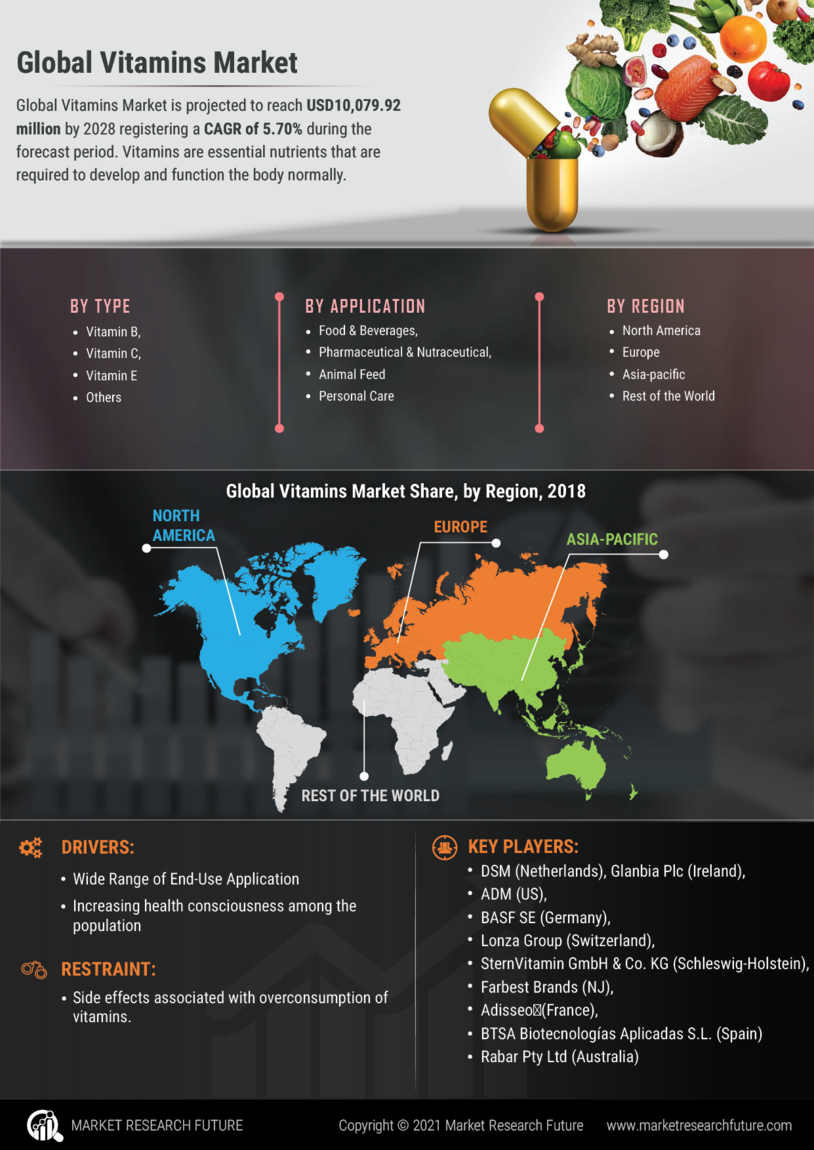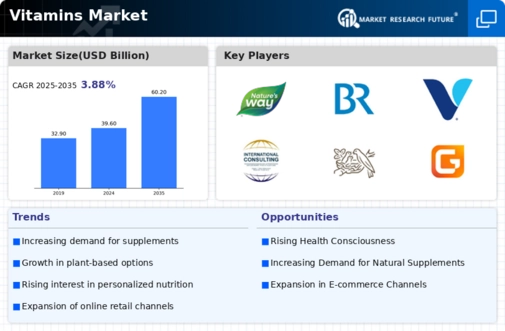Aging Population
The demographic shift towards an aging population significantly influences the Global Vitamins Industry. Older adults often require additional nutritional support to maintain their health and vitality, leading to increased demand for vitamin supplements tailored to their specific needs. This demographic trend is particularly pronounced in regions with high life expectancy, where the elderly population is projected to grow substantially. As a result, the market is expected to expand, with forecasts indicating a rise to 60.2 USD Billion by 2035. This growth underscores the necessity for the Global Vitamins Industry to innovate and develop products that cater to the unique health requirements of older consumers.
Market Growth Projections
The Global Vitamins Industry is poised for substantial growth, with projections indicating a market value of 39.6 USD Billion in 2024 and an anticipated increase to 60.2 USD Billion by 2035. This growth trajectory reflects a compound annual growth rate (CAGR) of 3.88% from 2025 to 2035. Such figures underscore the industry's resilience and adaptability in responding to evolving consumer demands and health trends. The market's expansion is likely to be driven by various factors, including rising health consciousness, an aging population, and technological advancements in production. These dynamics collectively position the Global Vitamins Industry for a promising future.
Rising Health Consciousness
The Global Vitamins Industry is experiencing a notable surge in demand driven by increasing health consciousness among consumers. As individuals become more aware of the importance of nutrition and preventive healthcare, the consumption of vitamins is likely to rise. This trend is particularly evident in developed regions where consumers actively seek supplements to enhance their overall well-being. The market is projected to reach 39.6 USD Billion in 2024, reflecting a growing inclination towards maintaining health through dietary supplements. This shift in consumer behavior suggests a robust future for the Global Vitamins Industry as it adapts to meet the evolving needs of health-focused individuals.
Growing E-commerce Platforms
The rise of e-commerce platforms is transforming the way consumers access vitamins, significantly impacting the Global Vitamins Industry. Online shopping offers convenience and a wider selection of products, catering to the preferences of tech-savvy consumers. This trend is particularly relevant in the context of a globalized market where consumers can easily compare products and prices. As e-commerce continues to expand, it is expected to drive sales growth within the industry, contributing to the overall market value projected to reach 39.6 USD Billion in 2024. The Global Vitamins Industry must adapt to this shift by enhancing online presence and optimizing distribution strategies.
Increased Focus on Preventive Healthcare
The Global Vitamins Industry is witnessing a paradigm shift towards preventive healthcare, as consumers increasingly prioritize wellness over reactive treatment. This trend is fueled by a growing body of evidence linking vitamin supplementation to improved health outcomes. As individuals seek to prevent chronic diseases and enhance their quality of life, the demand for vitamins is likely to rise. This proactive approach to health is expected to contribute to the market's growth, with projections indicating a value of 60.2 USD Billion by 2035. The Global Vitamins Industry must leverage this trend by promoting the benefits of vitamins in preventive health strategies.
Technological Advancements in Production
Technological advancements in the production of vitamins are reshaping the Global Vitamins Industry. Innovations in manufacturing processes, such as fermentation technology and biotechnology, enhance the efficiency and efficacy of vitamin production. These advancements not only improve product quality but also reduce costs, making vitamins more accessible to a broader audience. As the industry embraces these technologies, it is likely to witness increased competition and a wider variety of products. This evolution aligns with the projected compound annual growth rate (CAGR) of 3.88% from 2025 to 2035, indicating a dynamic and evolving landscape for the Global Vitamins Industry.




















Leave a Comment